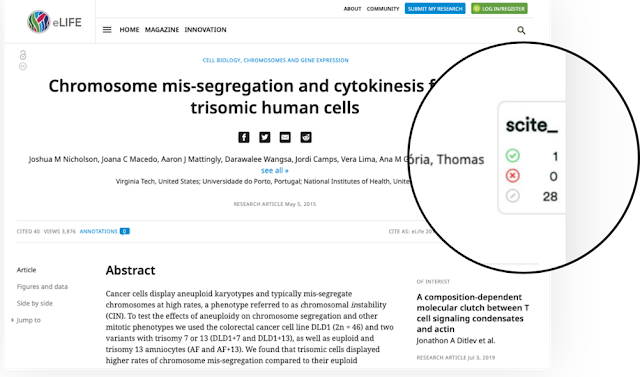This year’s annual ALPSP conference once again focused on the key issues facing society publishers – from Plan S and open access to diversity, copyright, and Brexit – offering a wide range of perspectives on how to navigate this changing landscape.
In the day’s opening keynote, The
Declaration on Research Assessment (DORA): Opening up the measures of success,
Professor Stephen Curry, chair of DORA, gave a wide-ranging overview of the
deficiencies of our current market-driven measures of success, suggesting many
urgent opportunities for improvement. Though metrics can be useful, he
suggested, too often they are too closely tied to extrinsic rewards or
misapplied by those who fail to understand their context. Our focus on journal
impact factors, for instance, slows publication, creates a bias towards
positive results, and even incentivises fraud. Many of these problems, Curry
argued, might be mitigated by the complementary adoption of article-level
metrics – which shift attention to the quality of articles themselves – and the
sharing of preprints, which increase circulation speed and encourage greater
scrutiny, thereby revealing flaws that might be missed by reviewers. More
nuanced journal-level metrics that assess the range of activities that journals
perform – from evaluation to archiving – would also be helpful. Ultimately, our
assessment of research should ensure that it is reliable and rapid, accessible,
and high quality, transforming our understanding of the world and changing it
for the better.
The following panel session, Breaking the
Glass Ceiling, chaired by Rebecca Asher of Sense About Science, saw
four industry leaders discuss the glass ceiling that still affects women within
the scholarly ecosystem. Leslie Yellowlees, the first woman president of the Royal
Society of Chemistry, described change within STEM as ‘glacially slow’; Amy
Brand, director of the MIT Press, noted the ‘subtle slights’ that discourage
women from developing their careers, from not receiving invitations to
overhearing negative comments, and recommended that women ‘engage head on’ with
these microaggressions. Sarah Greaves, publishing director at Hindawi, agreed,
arguing that women need actively to retrain themselves to challenge the
assumptions of authority, such as the persistent assumptions noted by Allison
Lang of the BMJ that, as a woman, she would make the tea and book taxis, and
act as her children’s primary care-giver.
Day two began with the launch of
the results
of the Society Publishers Accelerating Open Access and Plan S (SPA-OPS) project
in a panel session on Open
Transitions within Plan S, chaired by Alicia Wise of Information Power.
Funded by the Wellcome Trust and UKRI and conducted in partnership with ALPSP,
the project has issued a collection of outputs including 27 business models, a
model transformative agreement, and an implementation toolkit. Commenting on
the more than 100 responses received – two thirds from STEM societies; a third
from HSS – Rachel Bruce, Head of Open Science for UK Research and Innovation
(UKRI), noted society publishers’ reliance on hybrid models and the difficulties
they encountered in dealing with consortia. Lorraine Estelle of Information
Power then gave an overview of the toolkit while exploring the possibilities that
transformative models offer for society publishers, repurposing existing
institutional spending to provide predictable and attractive revenue streams
that nevertheless made content openly available. More than 90% of the library
consortia consulted for the survey, she noted, were keen to work with
publishers on exploring such models; and though they tended not to see current
spend as sustainable in the long-term, they were willing to accept a
cost-neutral transformation in the short term. Following Bruce, Gaynor
Redvers-Mutton shared some of the lessons the Microbiology Society had learned
from developing a Publish and Read
model as part of the project, flipping their business model
institution-by-institution and country-by-country through offering ‘all you can
eat’ access to all their journal content on payment of a single upfront fee.
The process was essential to the society’s own mission of sharing and promoting
biomedical research, but it had also been time-consuming and involved risks –
particularly financially – that they had attempted to mitigate through the
setting of time limits. Responses had been hugely positive, though some were
concerned that the society might be displaying commercial naivete. Shelley
Allen closed the session by discussing Emerald’s new open research platform
Emerald Open Research, launched in partnership with F1000 and focused primarily
on the humanities and social sciences, where funding for APCs is rarer and open
access content less common. Describing the platform as not a journal but a
web-based platform with an author-led approach, Allen explained that – as Curry
had suggested the day before, talking about preprints more generally – it
enabled rapid publication, open peer review, and for research to be judged on
its merits, not its place of publication.
Thursday’s second plenary session
saw
Sarah Faulder, Chief Executive of Publishers’ Licensing Services discuss ‘The
Changing Copyright Landscape Across the World and the Impact of Brexit’
with Elisabeth Ribbans, Director of Policy and Public Affairs for the British
Copyright Council. Conversation began with a discussion of the new EU copyright
directive, two years in the making, which has introduced a mandatory copyright
exception for text and data mining the contents of scientific journals for
scientific and research purposes; Faulder noted also that a new ‘bestseller
clause’ allowed authors to renegotiate contracts for works that outperform expectations.
However, given that the UK is set to leave the European Union during the
two-year implementation period, and that the government has as yet made no move
to implement the directive, its future status in UK law remains uncertain.
Considering further the UK’s position after leaving the European Union, Ribbans
observed that existing copyright law adopted by the UK should largely remain
unchanged, excepting databases, whose infrastructure would no longer be
protected; however, future trade agreements with the more copyright-liberal US
might threaten current protections.
Friday’s final sessions returned
to the subjects of open access and Plan S. In the first, Transforming
publishing: Sharing perspectives on the latest models to expand open access,
chaired by Dan Pollock of Delta Think, Springer Nature’s Steven Inchcoombe
explained that though publishers had been served well by subscription models,
they must accept the benefits that open access offers science, and find ways of
making it work for them. Ralf Schimmer of the Max Planck Digital Library
insisted that open access was the only legitimate business model in a fully
digital world, reminding listeners that there was already enough money in the
system to pay for it, while Niamh O’Connor of PLOS noted that the move to open
access would have its own long tail, with the timeline for open access books
looking very different to that for journals. Malavika Legge of the Biochemical
Society’s Portland Press shared some of the lessons drawn from the adoption of
open access models by a society heavily dependent on subscription revenues to
support its other work: don’t be distracted by deadlines, but learn by doing;
talk with other publishers, consortia, and institutions; and, be open about
routes to sustainable OA.
The session concluded with
discussion of Plan S – broadly welcomed, though with some concerns over its
prescriptiveness. This led neatly into
the conference’s closing session, Plan S - the
road ahead, in which Johan Rooryck, newly-installed OA champion at
cOAlition S, discussed the principles behind Plan S and recent changes in its
implementation guidance. With timelines extended by a year, a range of
transformative agreements would now be supported until the end of 2024, but
hybrid journals would remain uncompliant because they had been shown not to
work; immediate green OA would, however, be acceptable. Rooryck stressed that
the coalition was listening to stakeholders: it was working with researchers –
and particularly those in their early careers – to understand and then mitigate
their concerns, and with learned societies too: it would work with publishers
and other stakeholders to define the services involved in publishing and then
price them. Libraries would play a vital role in the transformation too,
particularly in converting subscriptions to open access payments.
 In addition to the plenary
sessions, this year’s conference once again included a wealth of parallel
sessions covering such key topics as diversity, early career researchers,
innovation, open peer review, open monographs, and the future of the book.
Thursday evening’s awards dinner also saw Ann Michael, Chief Digital Officer
for PLOS and founder of strategic consultancy Delta Think, honoured for her
lifetime contribution to scholarly publishing, while the award for innovation
in publishing Scite, a platform to
evaluate the reliability of scientific claims using deep learning models
alongside a network of experts. Also shortlisted were BMJ Best Practice from BMJ with
67 Bricks, preLights from the
Company of Biologists, and Ripeta.
In addition to the plenary
sessions, this year’s conference once again included a wealth of parallel
sessions covering such key topics as diversity, early career researchers,
innovation, open peer review, open monographs, and the future of the book.
Thursday evening’s awards dinner also saw Ann Michael, Chief Digital Officer
for PLOS and founder of strategic consultancy Delta Think, honoured for her
lifetime contribution to scholarly publishing, while the award for innovation
in publishing Scite, a platform to
evaluate the reliability of scientific claims using deep learning models
alongside a network of experts. Also shortlisted were BMJ Best Practice from BMJ with
67 Bricks, preLights from the
Company of Biologists, and Ripeta. 

























